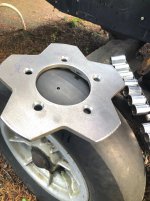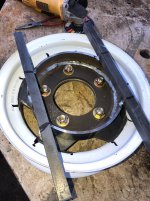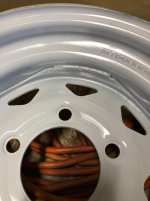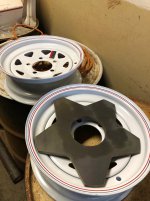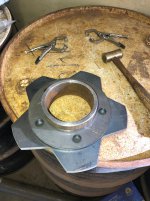Perhaps I should add some background about Scott’s attitude regarding bending fuel lines.
When I got the 1544, the steel fuel line from the fuel pump to the engine was not in great shape. It looked like a previous owner had tried some modifications by hand, and without tools, and that almost always results in a lousy outcome. There was an in-line filter between the fuel pump and carburetor, which was probably Chrysler’s design. But Tucker installs a filter before the fuel pump, so is that second filter really necessary? I didn’t think so and it makes the path of the fuel line longer. So my thought was let’s replace the stock fuel line with a new one and eliminate the inline filter. Scott then bent a new line. I’ll call that “Line 1”. I’m not sure why, but somewhere along the line it became necessary to bend another line and I’ll call that “Line 2”. While Scott is a fan of fuel injection, a big fan, actually, and the fuel injection system would REQUIRE new fuel lines, he drew a line and said "I’m not bending any more”. And unlike Obama’s famous line in the sand (that wasn’t), Scott stuck to his refusal.
Here’s a pic of Line 2 that was removed as part of the fuel injection installation. We need a moment of silence for this now removed artifact. If you think this is a big deal about nothin’... I can’t disagree.

As I already mentioned, a previous owner had Bubba and Billy Bob install a radio/CD player in the dash. I’m not sure which previous owner decided they needed a master disconnect electrical switch, but there was one of those, too. A great big rotary switch mounted above the instrument panel and being fed with seriously large electrical cables. Why? I mean having a master disconnect isn't a bad idea, but putting it there? I wanted to remove it, and…you guessed it... Scott didn’t.
We unbolted the instrument panel and Scott removed the radio/CD player and its wiring. I started the process of removing the disconnect switch. Scott was done before I was, and when I pulled the electrical cables from inside the cab I saw the red cable, with full battery amperage available, had exposed wire. I showed the exposed wire to Scott as further justification to eliminate the master disconnect, and he said he had seen that. One of the power wires for the radio/CD player was connected there. Unbelievable.... More Bubba and Billy Bob buffoonery.

Reading ahead on the Edelbrock installation instructions there is a very prominent warning about using an ignition coil that meets certain parameters, or severe damage to the ECU could result. One might think that with such consequences, and Edelbrock’s claim of “This kit includes everything you need for a hassle-free installation" that one would be supplied. Well, you might think that, but you’d be wrong. They provided a list of suggested ignition coils, and doing a little research I learned that ignition coils are typically oil filled, but for applications where increased vibration is likely, an epoxy filled coil is better. If you’ve ever been in a rubber belted Tucker on a hard surface, you are very familiar with vibration…. I ordered an epoxy filled coil.
We started the process of removing the superfluous wires and components I mentioned above and integrating the new Edelbrock wiring harness and the ECU (aka: computer). Right now it looks like a complete mess, but that’s basically the sausage making process as we get everything cleaned up and put together. To give Tucker some credit, in 1986 it looks like they’d made a change (or a previous owner upgraded the system) to using the Weather Pack system of electrical connection. We used this same system on Thundercat and CHUGSzilla, so we’re familiar with it, and like it. There are some special tools and a special crimper, but if you have those on hand (we do) it’s quite easy to work with. If you've tried working with the proprietary connectors on new vehicles (the Chrysler family's seem to be the worst) than you know how aggravating they can be. The Weather Pack system is much, much easier to work with!
We have a Tucker electrical schematic from 1978/1979, and unfortunately it doesn’t match the 1986 era wiring, but it is somewhat helpful, and we’ve been referring to that as we work our way through this. We strongly prefer not having to splice wires to extend them, but you have to work with what you have, and unfortunately we have to do that. We try hard to use the same color wires, or as close to that as we can, but sometimes it’s just not possible. For example, the Tucker harness had a blue wire with yellow spiral tracer that ran from the ignition coil to the tachometer. The Edelbrock harness had roughly a 6” long smaller gauge brown tachometer wire that would have to be lengthened by about six feet. We scrounged through our assortment of wires and found a very slightly larger gauge wire in a brown color that’s quite close. That will run all the way to the tachometer. Our objective is to make the harness as consistent as possible, and in a logical and easy-to-follow sequence. Unfortunately, the Tucker harness has some running splices (meaning an inline splice where a second wire is attached (essentially piggybacked) to the the first wire), and the second wire is a different color. Then that connection is buried in the harness. It makes tracing electrical issues orders of magnitude more difficult if there are future problems and one doesn’t have a schematic to reference.
It seems Tucker makes one harness that has provisions for various options. If a customer ordered the machine with them, then those wires would be used. If the options weren’t ordered, the wires are there, but not hooked up. There are wires run to a location for a relay, but since the option(s) weren’t ordered there is no relay in that location. We will leave that part of the system intact. It does give a future owner the possibility of installing the related option, or re-purposing those wires for another function.
Unfortunately, I can see someone cussing us out at some future date, but we are doing the best we can. Hopefully, that cussing will be minimal, and well in the future….
Yesterday, Mother Nature gave us a friendly reminder winter is fast approaching...we had some snow flurries at home.
When I got the 1544, the steel fuel line from the fuel pump to the engine was not in great shape. It looked like a previous owner had tried some modifications by hand, and without tools, and that almost always results in a lousy outcome. There was an in-line filter between the fuel pump and carburetor, which was probably Chrysler’s design. But Tucker installs a filter before the fuel pump, so is that second filter really necessary? I didn’t think so and it makes the path of the fuel line longer. So my thought was let’s replace the stock fuel line with a new one and eliminate the inline filter. Scott then bent a new line. I’ll call that “Line 1”. I’m not sure why, but somewhere along the line it became necessary to bend another line and I’ll call that “Line 2”. While Scott is a fan of fuel injection, a big fan, actually, and the fuel injection system would REQUIRE new fuel lines, he drew a line and said "I’m not bending any more”. And unlike Obama’s famous line in the sand (that wasn’t), Scott stuck to his refusal.
Here’s a pic of Line 2 that was removed as part of the fuel injection installation. We need a moment of silence for this now removed artifact. If you think this is a big deal about nothin’... I can’t disagree.
As I already mentioned, a previous owner had Bubba and Billy Bob install a radio/CD player in the dash. I’m not sure which previous owner decided they needed a master disconnect electrical switch, but there was one of those, too. A great big rotary switch mounted above the instrument panel and being fed with seriously large electrical cables. Why? I mean having a master disconnect isn't a bad idea, but putting it there? I wanted to remove it, and…you guessed it... Scott didn’t.
We unbolted the instrument panel and Scott removed the radio/CD player and its wiring. I started the process of removing the disconnect switch. Scott was done before I was, and when I pulled the electrical cables from inside the cab I saw the red cable, with full battery amperage available, had exposed wire. I showed the exposed wire to Scott as further justification to eliminate the master disconnect, and he said he had seen that. One of the power wires for the radio/CD player was connected there. Unbelievable.... More Bubba and Billy Bob buffoonery.
Reading ahead on the Edelbrock installation instructions there is a very prominent warning about using an ignition coil that meets certain parameters, or severe damage to the ECU could result. One might think that with such consequences, and Edelbrock’s claim of “This kit includes everything you need for a hassle-free installation" that one would be supplied. Well, you might think that, but you’d be wrong. They provided a list of suggested ignition coils, and doing a little research I learned that ignition coils are typically oil filled, but for applications where increased vibration is likely, an epoxy filled coil is better. If you’ve ever been in a rubber belted Tucker on a hard surface, you are very familiar with vibration…. I ordered an epoxy filled coil.
We started the process of removing the superfluous wires and components I mentioned above and integrating the new Edelbrock wiring harness and the ECU (aka: computer). Right now it looks like a complete mess, but that’s basically the sausage making process as we get everything cleaned up and put together. To give Tucker some credit, in 1986 it looks like they’d made a change (or a previous owner upgraded the system) to using the Weather Pack system of electrical connection. We used this same system on Thundercat and CHUGSzilla, so we’re familiar with it, and like it. There are some special tools and a special crimper, but if you have those on hand (we do) it’s quite easy to work with. If you've tried working with the proprietary connectors on new vehicles (the Chrysler family's seem to be the worst) than you know how aggravating they can be. The Weather Pack system is much, much easier to work with!
We have a Tucker electrical schematic from 1978/1979, and unfortunately it doesn’t match the 1986 era wiring, but it is somewhat helpful, and we’ve been referring to that as we work our way through this. We strongly prefer not having to splice wires to extend them, but you have to work with what you have, and unfortunately we have to do that. We try hard to use the same color wires, or as close to that as we can, but sometimes it’s just not possible. For example, the Tucker harness had a blue wire with yellow spiral tracer that ran from the ignition coil to the tachometer. The Edelbrock harness had roughly a 6” long smaller gauge brown tachometer wire that would have to be lengthened by about six feet. We scrounged through our assortment of wires and found a very slightly larger gauge wire in a brown color that’s quite close. That will run all the way to the tachometer. Our objective is to make the harness as consistent as possible, and in a logical and easy-to-follow sequence. Unfortunately, the Tucker harness has some running splices (meaning an inline splice where a second wire is attached (essentially piggybacked) to the the first wire), and the second wire is a different color. Then that connection is buried in the harness. It makes tracing electrical issues orders of magnitude more difficult if there are future problems and one doesn’t have a schematic to reference.
It seems Tucker makes one harness that has provisions for various options. If a customer ordered the machine with them, then those wires would be used. If the options weren’t ordered, the wires are there, but not hooked up. There are wires run to a location for a relay, but since the option(s) weren’t ordered there is no relay in that location. We will leave that part of the system intact. It does give a future owner the possibility of installing the related option, or re-purposing those wires for another function.
Unfortunately, I can see someone cussing us out at some future date, but we are doing the best we can. Hopefully, that cussing will be minimal, and well in the future….
Yesterday, Mother Nature gave us a friendly reminder winter is fast approaching...we had some snow flurries at home.

